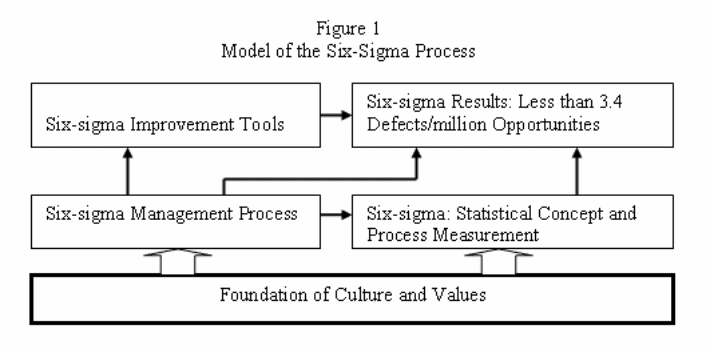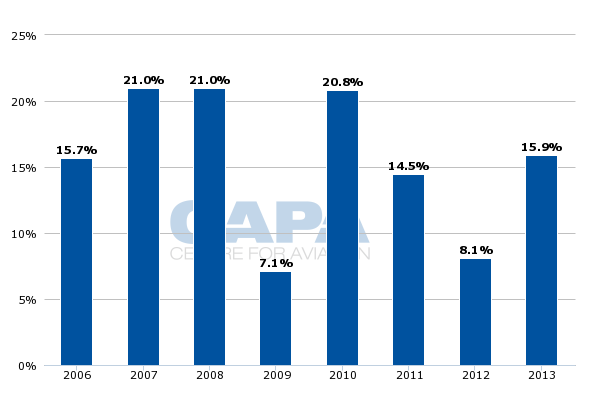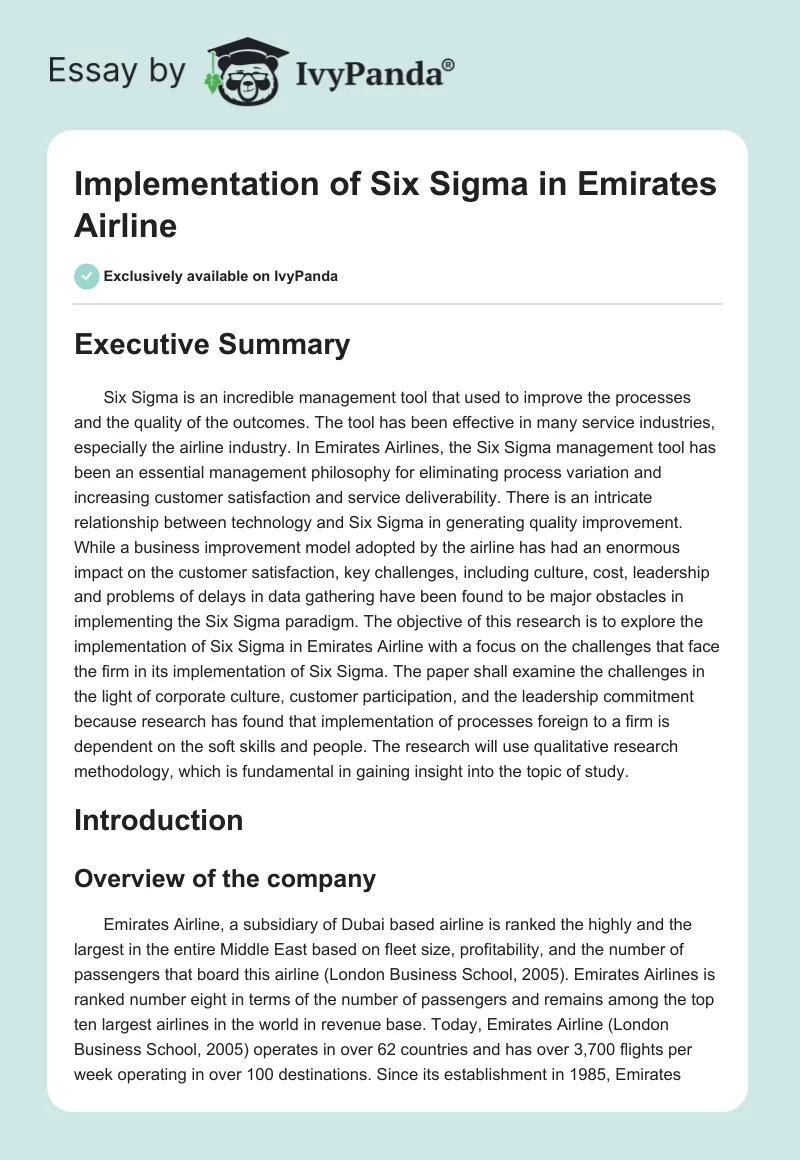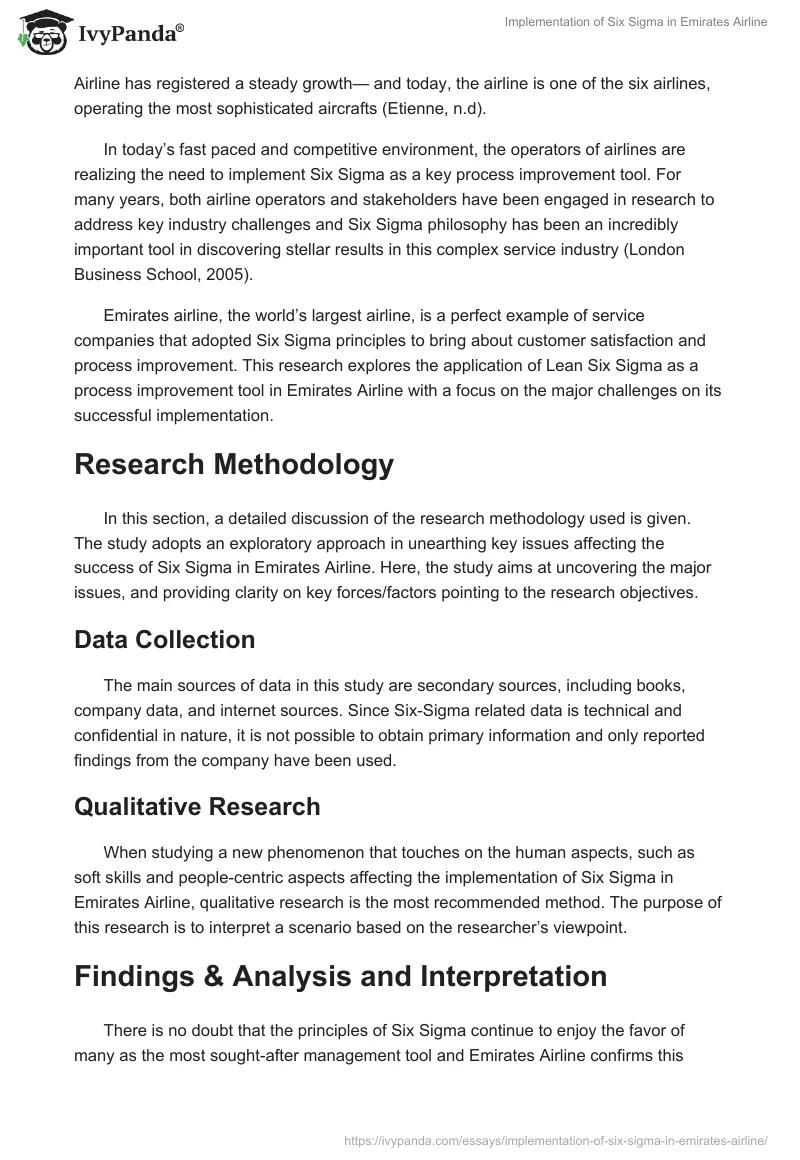Executive Summary
Six Sigma is an incredible management tool that used to improve the processes and the quality of the outcomes. The tool has been effective in many service industries, especially the airline industry. In Emirates Airlines, the Six Sigma management tool has been an essential management philosophy for eliminating process variation and increasing customer satisfaction and service deliverability. There is an intricate relationship between technology and Six Sigma in generating quality improvement. While a business improvement model adopted by the airline has had an enormous impact on the customer satisfaction, key challenges, including culture, cost, leadership and problems of delays in data gathering have been found to be major obstacles in implementing the Six Sigma paradigm. The objective of this research is to explore the implementation of Six Sigma in Emirates Airline with a focus on the challenges that face the firm in its implementation of Six Sigma. The paper shall examine the challenges in the light of corporate culture, customer participation, and the leadership commitment because research has found that implementation of processes foreign to a firm is dependent on the soft skills and people. The research will use qualitative research methodology, which is fundamental in gaining insight into the topic of study.
Introduction
Overview of the company
Emirates Airline, a subsidiary of Dubai based airline is ranked the highly and the largest in the entire Middle East based on fleet size, profitability, and the number of passengers that board this airline (London Business School, 2005). Emirates Airlines is ranked number eight in terms of the number of passengers and remains among the top ten largest airlines in the world in revenue base. Today, Emirates Airline (London Business School, 2005) operates in over 62 countries and has over 3,700 flights per week operating in over 100 destinations. Since its establishment in 1985, Emirates Airline has registered a steady growth— and today, the airline is one of the six airlines, operating the most sophisticated aircrafts (Etienne, n.d).
In today’s fast paced and competitive environment, the operators of airlines are realizing the need to implement Six Sigma as a key process improvement tool. For many years, both airline operators and stakeholders have been engaged in research to address key industry challenges and Six Sigma philosophy has been an incredibly important tool in discovering stellar results in this complex service industry (London Business School, 2005).
Emirates airline, the world’s largest airline, is a perfect example of service companies that adopted Six Sigma principles to bring about customer satisfaction and process improvement. This research explores the application of Lean Six Sigma as a process improvement tool in Emirates Airline with a focus on the major challenges on its successful implementation.
Research Methodology
In this section, a detailed discussion of the research methodology used is given. The study adopts an exploratory approach in unearthing key issues affecting the success of Six Sigma in Emirates Airline. Here, the study aims at uncovering the major issues, and providing clarity on key forces/factors pointing to the research objectives.
Data Collection
The main sources of data in this study are secondary sources, including books, company data, and internet sources. Since Six-Sigma related data is technical and confidential in nature, it is not possible to obtain primary information and only reported findings from the company have been used.
Qualitative Research
When studying a new phenomenon that touches on the human aspects, such as soft skills and people-centric aspects affecting the implementation of Six Sigma in Emirates Airline, qualitative research is the most recommended method. The purpose of this research is to interpret a scenario based on the researcher’s viewpoint.
Findings & Analysis and Interpretation
There is no doubt that the principles of Six Sigma continue to enjoy the favor of many as the most sought-after management tool and Emirates Airline confirms this assertion. Similarly, the achievements of Six Sigma Methodology remain convincingly non-controversial in the airline industry. However, the implementation of Six Sigma methodology has raised important questions about its ability to deliver on a firm’s objectives. The implementation of Six Sigma in Emirates has had a fair share of challenges and culture change has been pointed out as one of the major obstacles to the successful implementation of this largely beneficial management tool (Etienne, n.d).
Problems of culture change

The problem of culture change has been a major setback for Emirates. A major issue has been the challenge of changing corporate culture that follows a complex, bureaucratic and command-driven management system. Emirates Airline is the largest airline by customer base and its enormity of operations in terms of running a complex fleet network and huge labor that is established on strict management systems have been blamed for less than stellar success in the implementation of the Six Sigma process (Etienne, n.d).
The other challenge that faces Emirates Airline is the strict emphasis on safety, which is inherent in the industry of this nature. Usually, airlines are strict to detail as opposed to flexibility that applies to other service industries. Airlines such as Emirates have established a rather rigid culture over the last few years for genuine reasons. However, the question that Black Belt Sigma experts are asking is whether this culture is supportive of the Six Sigma approach.
Most airlines, including Emirates airlines have been established based on a more or less military management style—a strict orientation that has been difficult to change for many years (Etienne, n.d). While experts say that carriers need to adopt this culture because of the delicate nature of the industry, it has been rightly argued that firms that are unable to shed off this culture have found it difficult successfully implementing Six Sigma mechanisms.
Challenges collecting data for onward implementation of Six Sigma
The delays in data gathering, especially because of the non-quantitative nature of data in the service industry, have been attributed to problems of implementing Six Sigma. Since it is acceptable that collecting qualitative data takes a longer time than gathering data in a service company, it follows that the implementation process tends to take long as well (Nakhai & Neves, 2009). When other organizational priorities combine with these realities, it makes implementation task more tedious, especially in organizations such as Emirates Airline where a company implements a rapid results initiative program that seeks to deliver results in real-time (Nakhai & Neves, 2009). This means that it can be difficult to see a different outcome from the processes that never utilized the Six Sigma approach (Etienne, n.d).
Unpredictability of outcomes
Feedback in the airline industry often take longer than in other service industries such as the telecom industry, but this set of customers in the airline industry are looking for immediate changes. Unlike the service industry, the manufacturing sector is known to have processes that can be predicted more easily. The ability of a firm to predict with a fair degree of accuracy allows its operations team to measure the outcomes with much ease. This is not what happens in the airline sector. First, there are multiple tasks that a firm must accomplish to realize customer satisfaction, but it is difficult to complete or achieve all these aspects in a single transaction. This has meant that an airline operator such as Emirates must grapple with the challenges of fixing its customer satisfaction in a tight and highly competitive market (Patil, 2010).
It is becoming increasingly difficult to implement Six Sigma and its quality tools in the service industry that remains unpredictable (Nakhai & Neves, 2009). The airline industry is one of the most sophisticated sectors given that there are many factors that determine its progress. Emirates, like most airlines in the world, have difficulties implementing the Six Sigma because of the challenges of dealing with many forces that work on projects being implemented in this industry (Patil, 2010).
For instance, Emirates reports that its operations rely heavily on the projections of passenger turnover and the extent of distribution. Although predictions have over the years been used to figure out the position of the company in a particular market, the Airline sector has been hit hard because of the margins of error that come with predictions.
Challenges of measuring outcomes
Because the airline industry is one of the individualized industries, it is difficult to measure quality and establish the standard service quality that meets all the needs of passengers. Measurement of quality is achieved easily with physical products that can be standardized. Therefore, Emirates Airline has been faced with the challenge of wading through different customer demands and finding creative ways of measuring quality against perceived benchmarks.
Since a service industry is known to change dramatically, measurement processes and tools are supposed to change to align with what happens in the market (Patil, 2010). Therefore, Emirates Airline faces a serious challenge amending its Six Sigma measurement tools to obtain accurate or near accurate estimates of quality service. This has meant that Emirates Airlines has been faced with the challenge of dealing with processes of quality control as shown by unstable incomes in the figure below (Centre for Aviation and airline reports, 2013).

It is arguable that Six Sigma has inherent mechanisms that work to deliver on the project objectives, but one genuine concern that many companies have raised about this approach is the cost of implementing the approach, which remains a key challenge to achieving better return on investment (Patil, 2010). At the same time, where Emirates Airline has registered improved ROI due to better customer relationship management, Six Sigma has been behind the improvement. Therefore, while the cost of implementing Six Sigma approach has been lower than the actual return on investment, critics have argued that the margin between cost and returns has been slim (Patil, 2010).
The Commitment of top leadership
Six Sigma has been found to be successful in circumstances where a high ranking leadership is committed to providing necessary resources toward the process. As such, experts say that there is a close and intimate relationship between the top manager’s ability to be engaged in the change process and the success of the processes (Nakhai & Neves, 2009).
Customer contact and high customer interactions
Customer contact in the service industry can be a super problem in the implementation of six-sigma. This problem can be escalated in firms that allow their customers to participate in SDS (Patil, 2010). Regardless of how a service firm is determined, it is difficult for it to mobilize, train and offer motivation for its customers as it would for its own staff. Increased customer contact has the tendencies of introducing errors in the delivery process, thus increasing the variations in the outcomes of the six-sigma process (Nakhai & Neves, 2009). For many years, the service industry remained enslaved in the thinking that the providers should act as servitudes, a mentality that has offered inaccurate rationalization for non-utilization of process automation, which the cause of reduced productivity (Nakhai & Neves, 2009).
Conclusions and Recommendations
Conclusions
Like all other service providers, Emirates is focused on customer satisfaction. The way Six Sigma process is applied in the service industry varies significantly from the product sector—this emphasises the role of corporate culture and employee attitudes in ensuring high quality service for the customers.
Emirate’s Business Excellence model has been an intricate component in realizing improved customer satisfaction. This model has helped Emirates to grow from one level to another, keeping customer satisfaction in focus. Emirate’s process excellent process began with implementing lean approaches then followed by Six Sigma methodology. In an effort to drive operational improvement using the Six Sigma, the top management at Emirates has consistently redesigned the company’s business excellence model to match the changes in the industry.
In situations where the process and the results cannot be fully measured, most managers in a service company are less likely to acknowledge six sigma as one of the most effective quality improvement techniques. For six sigma to remain strongly rooted in a service company such as Emirates Airline, substantial efforts must be born to establish sound measurements that can accurately measure six sigma processes. If a firm fails to develop six sigma measures, there is a possibility that the organization will neglect Six Sigma or fail to implement key components and tools such as Taguchi. Similarly, if a firm lacks necessary commitment, it is likely that Six Sigma would be implemented in piecemeal.
Based on in-depth surveys conducted on 765 corporate managers across the world, the CEO’s ability to focus on innovation were influential in determining the direction, which the company will take. In the same study, the researchers found that CEO’s that ranked highly as lacking supportive culture were the major obstacle to a successful implementation of innovations. Similarly, organizations led by unsupportive leaders were unable to champion organization change to focus on the progressive implementation of new ideas, including the Lead Six Sigma. While the CEO of Emirates has been on the forefront of driving change, some evidence suggests that the industry’s tendency to slowly adopt changes has been a major drawback. From this backdrop, the organization must understand the culture and settings in which it operates as the basis of implementing Six Sigma.
Recommendations
Just like other quality improvement approaches, the success of six sigma is hinged on organizational culture and values, as these are critical components that generate and sustain commitment toward achievement of quality outcomes over the long-term. The role of organizational values in establishing a superior brand is recognized in literature. They include deeply rooted firm-wide customer consciousness, the passion for delivering quality service, insatiable desire for continuous improvement, high value staff, progressive implementation of innovation, an indisputably competitive spirit, the top management’s commitment for quality improvement, and trust embedded in the organization.
The fact that six sigma was born in firms that had a manufacturing background predisposes most leaders and employees in service industries to reject the possibility of applying six sigma on the premise that service industries are different from manufacturing companies. Therefore, firms such as Emirates Airline need to develop organizational infrastructure that can support skill acquisition. It means training staff to be able to implement six sigma projects.
Changing the culture of an organization means changing the behavior and the manner in which things are done. A sudden change in the behavior mode of behavior and the changes in the structure of operations are some of the things that have troubled Emirates. It can take ages for many organizations to break from the traditional mindset and Emirates should refocus on a systematic approach of amending its corporate culture to support new changes, including Six Sigma.
Although many people have attributed organizational problems with Six Sigma and not the successes of the methodology, it is clear that the methodology has both merits and downsides. Despite the thinking that Six Sigma has had a few challenges in most companies, especially Emirates Airlines, experts say that the most companies that have recorded failures in the implementation of Six Sigma have pertinent culture issues that need to be resolved.
References
Centre for Aviation and Airline Reports. (2013). Emirates’ 1H2013/14 15% growth: led by Saudi Arabia, Australia and UK, but full year looks slower. Web.
Etienne, E. C. (n.d). The Implementation Challenges of Six-Sigma In Service Business. International Journal of Applied Quality Management, 2(1), 1-24.
London Business School (2005). The Hub of the Word. Business Strategy Review, 36-40
Nakhai, B., & Neves, J. S. (2009). The challenges of six sigma in improving service quality. International Journal of Quality & Reliability Management, 26(7), 663 – 684.
Patil, R. (2010). A Study of Six Sigma Implementation Process at an Organization in Mumbai: To Develop a Model for Effective Implementation of the Six Sigma in Indian Organizations for Achieving Process Excellence. Mumbai: Padmashree Dr. D.Y.Patil University.


